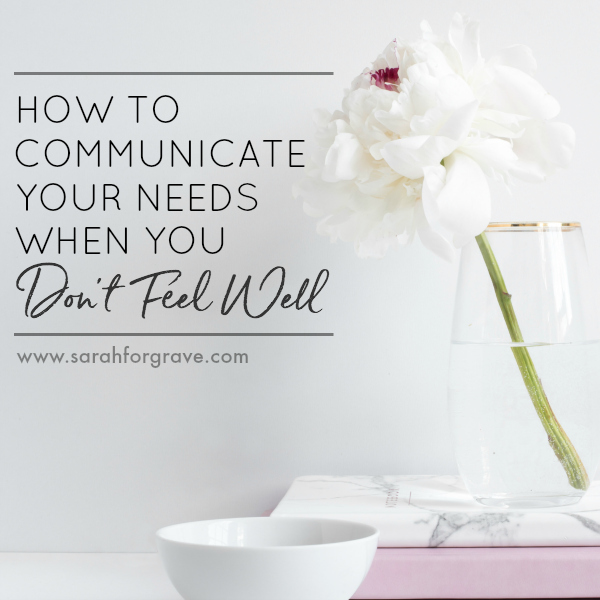Health challenges can make it hard to feel like ourselves. You may be dealing with physical pain while also battling frayed emotions, a weary spirit, helplessness, impatience, and more.
It’s especially hard when your condition impacts someone else. Whether you need focused care or you’re watching someone you love cope with your situation, it can be tricky to communicate what you need without pushing the person away.
The list I’m sharing today isn’t all-encompassing, by any means. You best know your situation and the person you need to talk with. But hopefully these will help you better communicate while keeping your relationships on solid footing.
These principles apply whether your needs are emotional (like patience and understanding from others), or they’re physical (like another glass of water when the person just retrieved something for you).
Filter your communication through the following tips, and rest at ease knowing you’ve done your best to maintain harmony.
1. Open with a statement of gratitude.
Before sharing what you need, be sure to affirm something in the person you’re talking to. If it’s a caregiver who’s worked tirelessly, tell them how thankful you are for their selflessness in caring for your needs. If it’s an acquaintance who may be overbearing with her phone calls, communicate how grateful you are for her interest and concern.
2. Be as specific as possible without hurting the person’s feelings.
Sometimes in our efforts to soften the blow, we skirt around the real issue and keep things vague. This may be okay depending on the circumstance. But if you have a specific need, it’s best to be clear. Otherwise, you may find yourself having this same conversation again in a short time.
If you truly need a glass of water because of your condition, you wouldn’t say, “I might enjoy a glass of water if you have the time. If not, it’s okay. I’ll survive.”
Be clear about your needs, but do so in a gracious, patient way. For example, “I really need a glass of water. I know you’re busy, but is there any chance you could bring me one in the next five or ten minutes? If not, could you please check with the nurse?”
For the overbearing acquaintance, you might say, “I appreciate your concern, but I’ve had a hard time sleeping lately. Would you be willing to limit your calls to once a day? I find I have the most energy around noon, so that would be the best time for a call.”
3. Keep your tone patient and calm.
Even if you’re feeling anything but patient and calm, take a deep breath and soften your voice. You may have to soften it to a level that feels extreme, but you’re better off erring on the side of too calm than rash and impatient.
4. Keep a relaxed posture and facial expression.
As much as physically possible, try to communicate gratitude through your physical cues. Now, obviously this doesn’t apply if you’re in a life-threatening situation and you need to urgently communicate your needs. But in a non-emergency scenario, pay attention to the stiffness of your shoulders and jaw. Are your eyebrows bunched tight, or are they relaxed?
It’s been said that what a person hears you say is only 7% based on the words you use. 38% is based on how you say it, and 55% is based on your body language.¹ Pay attention not only to your words, but also to the verbal and physical cues that accompany them.
5. Finish with another statement of gratitude.
Think about creating a sandwich in your communication. Affirm-request-affirm. I know this might seem like coddling to some of you. But the reality is, your message will be much better received and heeded if you communicate this way.
After asking for the glass of water, thank your caregiver again for their help. After asking your friend to reduce her phone calls, thank her again for her thoughts and prayers.
Physical challenges may test you to your limit, but they don’t have to push your relationships to the point of collapse. By learning to communicate your needs in a loving, patient manner, you’ll find that this time of struggle can be one of great enrichment in your interactions with those you love.
*photo by Her Creative Studio / CreativeMarket.com
¹Archer & Akert, 1977; Mehrabian & Ferris, 1967
